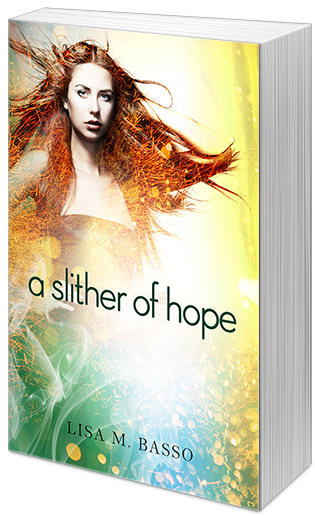A Slither of Hope Blog Tour Guest Post: Bringing cardboard characters to life with dialogue by Lisa M. Basso

 Title: A SLITHER OF HOPE (ANGEL SIGHT #2)Publication date: August 5, 2014Publisher: Month9Books, LLC.Author: Lisa M. Basso
Title: A SLITHER OF HOPE (ANGEL SIGHT #2)Publication date: August 5, 2014Publisher: Month9Books, LLC.Author: Lisa M. BassoRayna struggles to piece her life back together, but hiding in plain sight from the police, the SS Crazy, and the Fallen isn’t a foolproof plan—something Kade, the World’s Worst Roommate, reminds her of everyday. The late nights of failing to teach Ray how to protect herself against the Fallen are getting to Kade, changing him in ways he doesn’t like, and after a family emergency sends Ray back into Cam’s arms, Kade decides he’s had enough. News of Rayna’s resurfacing brings both angels and the Fallen to San Francisco by the dozens, all eyes scouring the city for the girl with the gray wings. Rayna will need both Kade and Cam’s help to ensure her family’s safety, navigate the new dangers and enemies springing up all over the city, and manage the surprises that arise with her new set of wings.
Chapters Indigo! | Amazon | Barnes & Noble | Kobo | The Book Depository | IndieBound |
I’m a huge fan of outlining. Huge. If I didn’t outline I wouldn’t know who my characters were, where they needed to go, what they needed to do, or how they would get to the climax—or even what the climax entailed. Pre-planning, like outlining, is also how I learn about my characters.
After learning a little about my plot and where I expect it to go, I begin focusing on my characters. To do this I begin listing character traits. Age, date of birth, hobbies, habits, likes, dislikes, physical characters, etc. If I still feel like something is missing when all of this is done, especially with my main characters, I’ll put on my Rita Skeeter hat (yes, I went there with the Harry Potter reference) and start asking them questions.
This might sound odd, to interview a fictional character, but for me, it works.
A character interview isn’t something every character gets, because not all of them need it. Only the illusive ones get the A1 special treatment. When I was first plotting out A Shimmer of Angels, Rayna, my main character, was giving me a lot of problems. I needed to know some of her past, how and why she ended up hospitalized for seeing angels, and what went on in her head at the time. So I pulled up a fresh word doc and went at it.
One trick to creating a successful character interview is to hone your character’s voice, hear them speak through you. After all, to create a realistic character, you can list traits and descriptions all you like, but until your character truly speaks they’re just words on a page. If you know enough about them, you can start to get a feel for their voice. Do they speak formally, or more modern? Do they have an accent? Do they curse? Are they shy or outgoing? What is their sense of humor like? All of these things will help you form a character voice. The interview will help you hone this voice—after all, practice makes perfect, right?
The second trick to the character interview is to ask the right questions. You might not need to know what their favorite brand of shoes are or what toothpaste they use, but you’ll probably want to ask about their upbringing and hopes for the future. During my character interview with Rayna, I started with the hard-hitting journalism right off the bat. That didn’t work for her, she clammed up. So I switched to something easier, her current home life. As the interview went on (and I know this might sound crazy to some of you, but stay with me here), we both became more comfortable. She began to open up. My questions got tougher and her answers got more honest. I learned so much about her in the few short pages on the screen.
Once you have a voice, the next step is to improve it. Put them in a scene with someone else and get them talking. The first scene I wrote in A Shimmer of Angels (with my new, fully formed Rayna) was her having a conversation with Lee (her best friend). Who better for a character to talk to then their best friend? To my surprise, that scene, while rewritten several times, ended up staying as the first scene in the book. My advice, write a lot of dialogue. Through these first scenes of dialogue, I discovered Lee was an awesome technology loving, pop culture geek.
You learn so much more about your character seeing them interact with other characters, especially when there’s conflict involved. Ray’s first few interactions with Cam, the angel at her school, were tense and awkward, which brought out a lot of Ray’s insecurities. While her interactions with Kade, the dark-winged Fallen in the book, brought out another part of Rayna. She was scared of Kade and his never-before-seen black wings, but she also bolstered herself, made sure he didn’t see her fear. And just like that, she became stronger.
Each character’s voice is just as important and distinct as the author’s voice. No two characters will have the same life experiences, so they shouldn’t sound exactly the same. No matter how you do it, the key to a solid, multidimensional character is making them as real as possible. And for me, when I can hear their voice in my head as I type, that’s when I know I’m no longer writing for me, I’m writing as them.
 Lisa M. Basso was born and raised in San Francisco, California. She is a lover of books, video games, animals, and baking (not baking with animals though). As a child she would crawl into worlds of her own creation and get lost for hours. Her love for YA fiction started with a simple school reading assignment: S.E. Hinton's The Outsiders. When not reading or writing she can usually be found at home with The Best Boyfriend Fiancé that Ever Lived ™ and her two darling (and sometimes evil) cats, Kitties A and B.
Lisa M. Basso was born and raised in San Francisco, California. She is a lover of books, video games, animals, and baking (not baking with animals though). As a child she would crawl into worlds of her own creation and get lost for hours. Her love for YA fiction started with a simple school reading assignment: S.E. Hinton's The Outsiders. When not reading or writing she can usually be found at home with The Best Boyfriend Fiancé that Ever Lived ™ and her two darling (and sometimes evil) cats, Kitties A and B.Author Links: Website | Twitter | Facebook | Goodreads
Winner will be drawn August 29, 2014 · Four (4) winners will receive a digital copy of A Slither of Hope by Lisa M. Basso (INT)· One (1) winner will receive a digital copy of A Slither of Hope by Lisa M. Basso AND a $10 Amazon Gift Card or B&N Gift Card – Winner’s Choice (INT)
a Rafflecopter giveaway
Published on August 14, 2014 00:01
No comments have been added yet.



